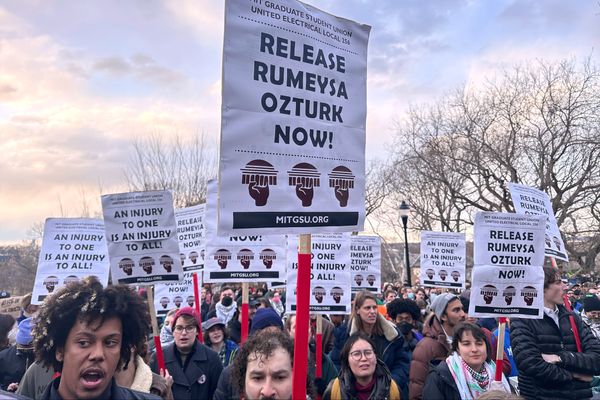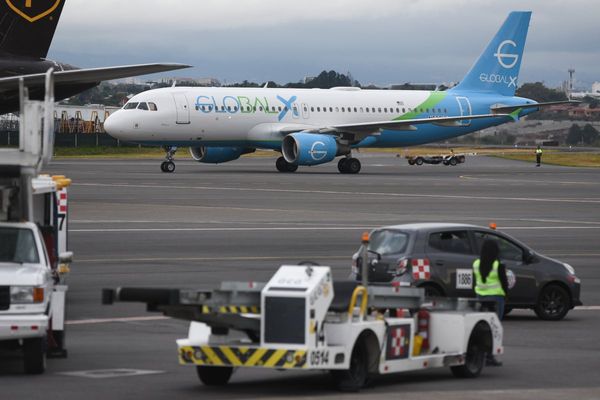
Can anybody stop Trumpism? Progressives are understandably worried. Though federal judges may temporarily pause some of the new administration’s most brazenly illegal executive orders, a hyper-conservative supreme court lies waiting in the wings. And looking ahead to 2028, it’s hard to feel hopeful about defeating Maga given that the Democratic party continues to hemorrhage working-class voters.
But there’s no need to despair. A powerful force in our society has the legitimacy, resources and leverage to turn things around: organized labor. Unions can beat back Donald Trump’s attacks, expose his sham populism, and – by uniting workers around their shared economic interests – help isolate his xenophobic scapegoating.
Rather than hibernate for the next four years, or limit ourselves to posting online about the president’s latest outrages, each of us can lend support to workers organizing at federal agencies, schools, Starbucks, Amazon, auto plants and beyond. Just as importantly, we can expand the labor movement’s reach by unionizing our own workplaces. It won’t be easy to counter Trump’s shock-and-awe offensive, or to fill the void left by the Democrats’ disarray. But it’s both necessary and possible.
Consider Trump’s latest moves. While he can appoint his cronies to head crucial civil service agencies, it is still unionized federal employees who make these institutions run. And their resistance to his power grab – through defying the new administration and enlisting public support – constitutes our best hope for protecting these services upon which millions of Americans depend.
Remember the government shutdown during the first Trump administration? By late January 2019, the crisis had already lasted a month, with no end in sight. But then the flight attendant leader Sara Nelson began making national waves by agitating for a general strike, stressing the public safety dangers of not paying the people whose labor makes air travel possible. On 25 January, various air traffic controllers refused to come into work, resulting in a temporary grounding of New York flights. Only a few hours later, Trump announced a deal to end the shutdown.
Resisting Maga’s barrage is crucial. But it would be a mistake to fight only on the right’s chosen political terrain. Trump’s achilles heel is that he won by speaking to the economic grievances of working people, but heads an administration of and for billionaires obsessed with maximizing their own profits and control. Centrist Democrats have generally been unable to expose this contradiction, as they too are often tied to big business. But combating corporate greed is the labor movement’s bread and butter, which is why unions in our era of rampant inequality are experiencing record-high levels of popularity, even among conservatives and independents.
The administration’s connection to the world’s richest men – Elon Musk, Jeff Bezos, Mark Zuckerberg – makes it easier for anti-Trump sentiment to channel into workplace battles. When Tesla factory workers unionize, or coders at X push back against their boss, this is now de facto a confrontation with the White House. By scaling up high-publicity union drives and strikes for economic dignity across the country, labor and its supporters can force politicians to show which side they’re really on.
Even labor struggles focused on economic issues can have dramatic political repercussions. Faced with Trump’s efforts to deprive workers of the right to unionize by kneecapping the National Labor Relations Board, every union drive is now on a collision course with the new regime. Moreover, since workplaces bring together people from a wide range of backgrounds and ideologies, union organizing requires listening to and persuading people who disagree with us, a skill sorely lacking among most progressives today. Effective persuasion happens not by haranguing or shaming others, but rather by finding points of commonality – often economic – around which working people can come together.
Through this patient process of building solidarity across differences, labor organizing is uniquely positioned to convince large numbers of Americans to direct their anger at the bosses above (and their political proxies), instead of immigrants or trans people. Unsurprisingly, union members voted for Kamala Harris by a 16-point margin in the last election; indeed, Trump would probably have lost had the US labor movement represented a significantly higher percent of the American workforce.
Despite Trump’s constriction of labor rights, conditions overall remain favorable for union growth. Organized labor, for example, is sitting on an unprecedented war chest of roughly $38bn in assets, over a third of which are highly liquid. This is more than enough to defend against Project 2025 while simultaneously going on the offensive against corporate America. Big, assertive unionization battles could lay bare Trump’s oligarchic allegiances, while pressuring Democratic politicians to champion economic populism.
Unfortunately, it’s unclear whether union officials will finally find the chutzpah to break from business as usual. Most remain exceedingly risk averse, narrowly focused, and deferential to establishment politicians. For that reason, labor’s post-pandemic upsurge has been driven from below, with young, left-leaning workers taking the lead – most recently at the Whole Foods in Philadelphia that voted for a union last Monday. But to scale up widely enough to transform the US, this grassroots uptick will need deep-pocketed labor leaders to fully jump into the fight.
It remains to be seen whether unions can rise to the challenge of Trumpism. For the sake of our democracy, our livelihoods, and our planet, let’s hope they do.
What’s giving me hope now
What’s giving me hope is that Philadelphia Whole Foods workers last Monday voted to unionize, 130 to 100. It’s a really big deal: this was only the second time American workers have defeated Amazon in a union election. Many in the labor movement were expecting a loss, since Maga is now in office and since management – headed by Trump’s new billionaire buddy Bezos – went scorched earth against the nascent union effort. But a multiracial crew of young, self-organized, left-leaning workers proved the skeptics wrong, as so often has been the case since 2021. Labor passed its first big test under Trump, and hopefully we’ll see many similar wins in the months to come.
Eric Blanc is the author of We Are the Union: How Worker-to-Worker Organizing is Revitalizing Labor and Winning Big, which is out with UC Press in February 2025







